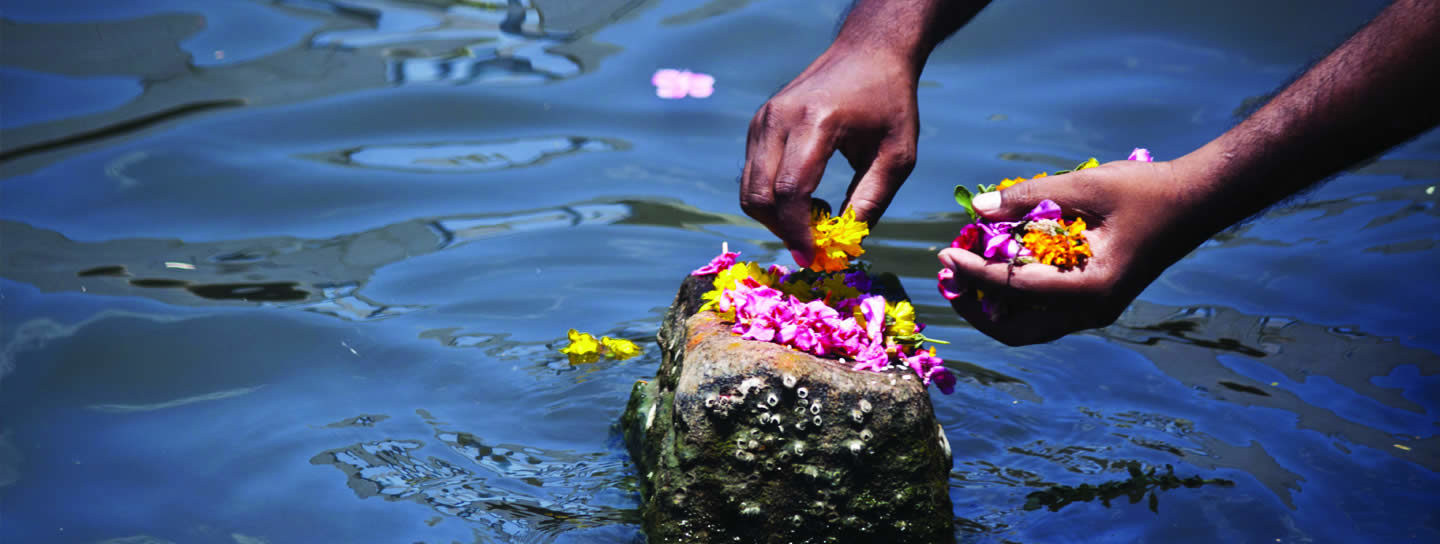Places Of Interest
Like all tirthas, Rameswaram has one central temple and a number of smaller shrines, most of them with temple myths woven around the Ramayana. Lord Rama’s journey and stay here has been marked by these temples where pilgrims have worshipped for centuries. Scholars have traced his journey through the Ramanathapuram region through the Sanskrit verses mentioned in Valmiki’s Ramayana. Book rooms in Rameswaram online and make your trip a memorable one.
The temples and places popular with pilgrims in Rameswaram are given below:
This temple stands where Vibhishana met Rama for the first time after leaving Lanka. After failing to convince his brother Ravana of his evil ways a saddened Vibhishana joined Rama. Later he was crowned as the king of Lanka at this spot. The paintings on the wall of the temple narrate the story of his arrival and coronation. The deities in the garbha griha are of Rama, Sita, Lakshman and Vibhishana.
The temple stands on a small hill and it is said that when Hanuman came first to Rameswaram while searching for Sita, he took his leap to cross the sea from here. Later when Lord Rama arrived, Hanuman took him to the hill top to show him Lanka in the distance. Even today, on a clear night one can see the lights of Jaffna in Sri Lanka across the bay. Rama’s footprints can be found here, carved within a marble chakra inside a small shrine and the temple is also called Ram Jharokha.
Dhanushkodi is that magical spot where the waters of the Bay of Bengal blend into the Indian Ocean creating a very rare and sacred confluence of waters. The beach is at the tip of the island, with the Palk Bay to its north and the Mannar Bay to the south. Much of Dhanushkodi and its ancient temples were destroyed in a cyclone in 1964, only the Kodandarama temple survived. A new temple to Hanuman has been built recently.
Vilundi Teertha
Rama created a sweet water spring here by aiming an arrow. The well is located in the sea and still has sweet water.
Ram Temple
The temple marks the site where Rama held a discussion with his ministers before the battle.
Jata Teertha
The sacred tank stands on the way from Rameswaram to Dhanushkodi. Rama washed his jata, his long hair here.
Rama Teertham, Lakshaman Teertham and Jatayu Teertham.
All of them have sacred bathing tanks.
Hanuman Temple
This has the famous floating rocks said to have been used to construct the Ramasetu.
Rama came here with Vibhishana and at his suggestion he lay on a bed of holy darbha grass as a penance for seven days before praying to Varuna, the God of the oceans. Rama prayed that the ocean would move away. When Varuna refused an angry Rama picked up his bow swearing he would dry up the waters. At which Varuna promised to support the bridge built by Rama’s vanar army. The Agni Purana says that the bridge was built at Tirupullani and this bridge was called Adi Setu, though other traditions place the bridge at Dhanushkodi.
Rama worshipped Vishnu here in his form of Adi Jagannatha and the god presented Rama with a celestial bow called Divya Sarabham. Vishnu also promised to stand guard at the bridge. After his coronation at Ayodhya, Rama and Sita returned to perform a yagya of thanksgiving and there is a shrine within the temple precinct called Pattabhishekha Rama that commemorates the occasion.
Here Vishnu is depicted in the sayanam posture, lying below the hoods of the serpent king Sheshanaga and images of his two consorts Sridevi and Bhudevi stand nearby. There is also a popular amman shrine dedicated to Lakshmi next to the main temple and here the consort of Vishnu is called Padmasani Thayar.
As its name shows, this coastal tirtha is dedicated to the Devi. Rama prayed here to Durga and the nine planets, the Navagraha. The goddess went to stand guard at the Ramasetu and the nine planets promised Rama victory. During the yagya Rama placed nine stones upright in the shallow bay and worshipped them and the site is called Navapashanam, the nine sacred stones. The stones are near the Thilakeshwar Temple dedicated to Shiva and Durga. The image of the goddess depicts her as a warrior carrying weapons in her eight hands.
Shiva Temple
The temple is 10 km south of Muttukuda, over 110 km from Rameswaram. Here Rama worshipped Shiva as commanded by Agastya Muni.
Tapnashan Vinayak Temple, Uppur
When Rama and Lakshman were exhausted by the heat, they took a bath here and worshipped Lord Ganesha.
Setu Chhedukarai
The first foundation of a sea bridge was laid here and there are remains of the Ramasetu or Rama’s Bridge. The final bridge was built at Dhanushkodi.
MADURAI is one of the oldest temple towns of India. At its heart stands the magnificent Meenakshi Temple where Lord Shiva and his consort, the goddess Parvati are worshipped as Lord Sundareshwara and the warrior-princess Meenakshi. It is said that Lord Vishnu himself came to give the bride away. The present temple, built in the 17th century by Nayaka kings has twelve soaring gopurams, a thousand pillar hall and exquisite sculptures. It’s most popular festivals are Chittirai (April/May) and Teppam (January) when the deities are taken out in colourful processions. Madurai is 170 Km from Rameswaram.
KANYAKUMARI stands at the southernmost tip of the Indian peninsula. Here we see a rare and sacred confluence of three oceans, the Bay of Bengal, the Indian Ocean and the Arabian Sea. The Kanyakumari Amman Temple is dedicated to the virgin goddess Parashakti, an aspect of Parvati. There is also the Vivekananda Rock Memorial where the famous sage meditated on an island in the ocean. Kanyakumari is 290 Km from Rameswaram.
The Uthirakosamangai Temple is an ancient Shiva temple with the deity carved in an emerald.
The Gurudwara Nanak Dham, visited by the founder of the Sikh faith, Guru Nanak.
The Erwadi Dargah, the grave and shrine, built in the 12th century, of the Muslim saint Qutbus Sultan Syed Ibrahim Shaheed Badusha.
All the Tour packages are valid upto 30th September,2012


